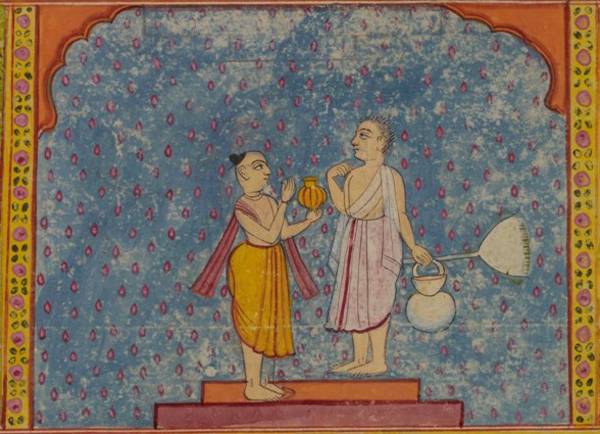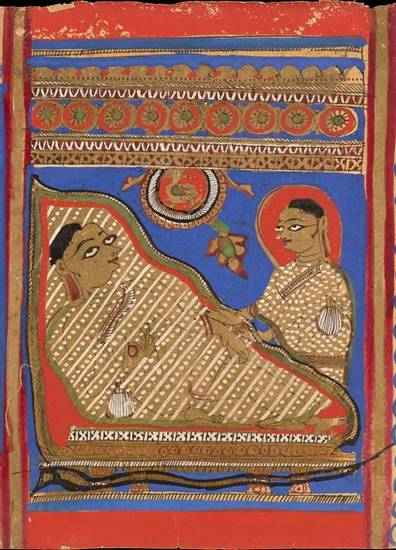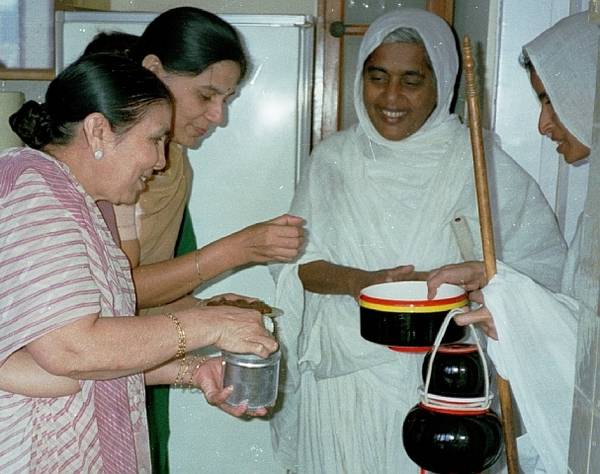Article: Candanbālā
Candanbālā, also known as Candanā, was the head nun under Mahāvīra and is one of the 16 satīs – soḷ satī. Her story is especially well known because she appears at a key moment in Mahavira’s progress to becoming a Jina. For both Digambara and Śvetāmbara Jains, Candanbālā is one of the many Jain satīs whose lives are examples of the ideal path for women. She also demonstrates virtues that should be imitated by both men and women. Her story features the quintessential gift to the worthy recipient – supatra dāna – offering food, clothes and medicine to a Jain mendicant as alms.
Among Śvetāmbaras, Candanbālā’s story is re-enacted as part of the fast-breaking ritual associated with the Candanbālā Fast. The three-day fast is completed when the faster feeds a Jain mendicant before breaking her own fast. In addition to reducing karma, the Candanbālā Fast is believed to improve the faster’s beauty and marriage prospects.
Story of Candanbālā
Princess Vasumatī is born in the city of Campa. When Campa is sacked in a war, a camel trader grabs the princess and her mother, who dies immediately. He offers Vasumatī as a slave in the market, where a Jain merchant named Dhana sees Vasumatī and realises that she must be a kidnapped princess. He buys her and decides to raise her as his own daughter until her family finds her. He and his family call her ‘Candanbālā’, which means ‘Hair like Sandalwood‘, because of her beauty.
Candanbālā is punished for her beauty
As Candanbālā grows more beautiful, the merchant’s wife, Mulā, becomes jealous of her. She orders the servants to shave off Candanbālā’s hair, bind her with chains and lock her in a distant corner of the house. For three days, whenever the merchant asks after Candanbālā, his wife lies to him that she is outside or asleep.
When Dhana finally convinces the servants to tell him where Candanbālā is, he finds her shaven-headed and chained, with tears in her eyes. She has not eaten or drunk for three days. He searches for something for her to eat but there is only a winnowing basket full of lentils. Candanbālā vows that she will eat only after first giving food to a guest.
Mahāvīra seeks alms
At this very moment the 24th Jina Mahāvīra comes seeking alms. He has been fasting for five months and 25 days, awaiting a suitable donor. He has vowed to accept food only from a princess who is now a slave, standing on the threshold with her head shaved, dressed in white, crying while sorting lentils in a winnowing basket.
Candanbālā stands in the doorway of her room with the winnowing basket full of lentils and calls to Mahāvīra that he should take alms. He refuses because she is not crying. She begins to weep. Because Candanbālā then meets all the conditions of his vow, he returns to take alms.
At the fulfilment of Mahāvīra’s vow, the gods shower them both with gold, Candanbālā’s chains break off, her long beautiful hair miraculously returns and she is known instantly to be Princess Vasumatī.
Candanbālā follows Mahāvīra
After Candanbālā’s true identity is revealed, Mahāvīra tells the merchant, who had become like a father to her, to protect her until Mahāvīra becomes enlightened and she can renounce.
Later, Candanbālā renounces the life of a lay Jain under Mahāvīra. She then becomes his first female disciple and the head of the order of nuns under him.
At the end of her life Candanbālā achieves enlightenment, according to Śvetāmbara versions. In Digambara accounts of the story, she is reborn as a male god in one of the heavens.
References in Jain writings
Although Candanbālā, called Candanā in earlier texts, is first introduced in the fifth-century Kalpa-sūtra, her story became a moral one some while later. Since Candanbālā’s life story emphasises the merits of giving alms in the right way, it has appeared in collections of sermons and moral tales for hundreds of years. It is one of the most popular tales of satī or virtuous women in the present day, often found in independent versions as well as in collections of stories. A popular Śvetāmbara episode recounts Candanbālā’s reaching omniscience.
Candanbālā is named as the nuns‘ leader under Mahāvīra in the Kalpa-sūtra, but her story does not develop until the āvaśyaka commentaries of the seventh and eighth centuries. The earliest telling of her story is found in Jinadāsa’s Āvaśyaka-cūrnī as a story demonstrating the merits of proper alms-giving. The version in modern texts and contemporary retellings follows the model given above. However, earlier versions of the story have Candanbālā weeping when Mahāvīra arrives.
Like many Jain satīs, Candanbālā’s story appears in Śubhaśila-gaṇi’s 15th-century Bharateśvar Bāhubalī Vṛttiḥ and the later popular texts based on these collections. In the 18th century the Upadeśaprasāda, a popular collection of sermons, includes Candanbālā’s story because it shows the rewards of being a donor.
There are many hymns, including sajjhāys and stavans, that tell the story of Candanbālā. Hers is the most widely retold satī narrative in contemporary publications. The tale is found in every satī collection and there are books dedicated to her story alone. The Candanbālā story is the subject of several Jain DVDs and comic books as well, suggesting her ongoing popularity with younger as well as older Jains.
Mṛgavatī and the snake
In Śvetāmbara tellings from the medieval period forwards, there is an episode recounting the omniscience of Candanbālā. This popular episode is first found in the 12th-century universal history text by Hemacandra, the Triṣaṣṭi-śalāka-purūṣa-caritra.
One night after Candanbālā has become the leader of the order of nuns, the nun Mr̥gāvatī innocently returns late to the mendicants‘ lodgings. As a result of the profound nature of her apology to Candanbālā and her resulting loss of ego, Mr̥gāvatī reaches omniscience. This allows her to see a snake moving in the darkness towards the arm of Candanbālā, who is asleep. Mr̥gāvatī lifts the sleeping woman’s arm so the snake cannot bite her.
Candanbālā wakes up and asks how Mr̥gāvatī could see the snake in the perfect darkness. She recognises that Mr̥gāvatī has attained omniscience. The power of this realisation leads to Candanbālā’s also reaching omniscience.
The Candanbālā Fast
The involuntary fast Candanbālā undergoes in her life story has inspired a three-day fast among Śvetāmbara Jains. Just as Candanbālā does, the faster offers alms to an ascetic before breaking her fast. At this point the faster usually re-enacts the binding of Candanbālā and her offering of the lentils to the mendicant. The Candanbālā Fast is performed only by women, who choose to do it because many Śvetāmbaras believe that, as well as reducing karma, it enhances beauty and is an auspicious fast for attaining a good marriage.
The Candanbālā Fast involves three days and nights without eating. Fasters can only drink boiled water and that only during daylight hours. The defining feature of this Jain fast is the offering of alms before the fast is broken. After the mendicant has been offered boiled black lentils as alms, the faster then ends the fast by eating the same kind of lentils.
In practice, the fast-breaking of the Candanbālā Fast involves some degree of acting out the Candanbālā story. Usually the lentils are offered to a mendicant by the faster from the corner of a winnowing fan. Customarily, the faster’s hands or feet are tied together to symbolise Candanbālā’s chains. The faster is often dressed in white as well. The dramatisation of the story might include full-length dance-dramas, the building of a hut from which Candanbālā comes out to feed the mendicant or real chains to bind the faster’s hands and feet.
Effects of the Candanbālā Fast
Jains consider the Candanbālā Fast to be effective in lessening karma, as with all fasts. Only women undertake this fast, partly because it is widely believed to make the faster more beautiful, enhancing her hair especially. This increased beauty is seen as an asset in making a good marriage and the Candanbālā Fast is often named as a suitable fast for ensuring successful marriage agreements.
Reading
- ‘The Micro-Genre of Dāna-Stories in Jaina Literature: Problems of Interrelation and Diffusion’
Nalini Balbir - Indologica Taurinensia
edited by Nalini Balbir and Colette Caillat
volume 11
International Association of Sanskrit Studies; 1983
- Gender and Chastity: Female Jain Renouncers
Sherry Fohr - PhD dissertation submitted to University of Virginia in 2001
- ‘Thinking Collectively About Jain Satīs’
M. Whitney Kelting - Doctrines and Dialogues: Studies in Jaina History and Culture
edited by Peter Flügel
Advances in Jaina Studies series; volume 1
Routledge Curzon Press; London; 2006
- Heroic Wives: Rituals, Stories and the Virtues of Jain Wifehood
M. Whitney Kelting - Oxford University Press USA; New York, USA; 2009
- Honour, Nurture and Festivity: Aspects of Female Religiosity amongst Jain Women in Jaipur
Josephine Reynell - PhD dissertation submitted to University of Cambridge in 1985
- +
- aAbhavya
- aAbhinandana
- aAbhiṣeka
- aĀcāra
- aĀcārāṅga-sūtra
- aĀcārya
- aAchalbhrata
- aAḍhāī-dvīpa
- aAdharma
- aAdho-loka
- aAdhyayana
- aAdvaita Vedānta
- aĀgama
- aAghātīya
- aAghātīya-karman
- aAgnibhuti
- aAgra
- aĀhāra
- aAhiṃsā
- aAhimsa Day
- aAjita
- aAjīva
- aAkampit
- aĀkāśa
- aAkbar the Great
- aAkṣaya-tṛtīyā
- aAlauddin Khalji
- aAlbert Einstein
- aAllah
- aAlms
- aĀlocanā
- aAloka-ākāśa
- aAmāri
- aAmbikā or Kūṣmāṇḍinī
- aAnagāra
- aAnanta
- aAnarthadaṇḍa
- aAnaśana
- aAnekānta-vāda
- aAṅga
- aAniconism
- aAnojjā
- aAntarāla
- aAntarāya-karma
- aAṇu
- aAṇu-vrata
- aAnukampā
- aAnuprekṣā
- aAnusvāra
- aApabhraṃśa
- aAparigraha
- aAra
- aĀrambha
- aĀrambhaja
- aĀratī
- aArdhamāgadhī Prākrit
- aArhaṃ
- aArhat
- aArśana-āvaraṇīya-karma
- aĀrta-dhyāna
- aĀryikā
- aĀryikā Jñānamati
- aĀśātanā
- aĀścarya
- aAscetic
- aAsceticism
- aAshram
- aAspiration
- aĀsrava
- aAṣṭa-maṅgala
- aAṣṭāpada
- aAstikāya
- aAstrolabe
- aAsura
- aAtheism
- aAticāra
- aAtiśayakṣetra
- aAtithisaṃvibhāgavrata
- aĀtma-vāda
- aĀtman
- aAuṃ
- aAurangzeb
- aAuspicious
- aAusterity
- aAvadhāna
- aAvadhi-jñāna
- aĀvaraṇī-yakarman
- aAvasarpiṇī
- aAvatāra
- aAvidyā
- aAxiom
- aĀyāga-paṭa
- aĀyambil
- aĀyu-karma
- aĀyurveda
- bBabur
- bBāhubali
- bBaladeva
- bBālāvabodha
- bBandha
- bBasadi
- bBazaar
- bBhadrankarvijay
- bBhagavant
- bBhaktāmara-stotra
- bBhakti
- bBhale
- bBharata
- bBhāṣā
- bBhāṣya
- bBhaṭṭāraka
- bBhāva
- bBhāva-pūjā
- bBhāvanā
- bBhavana-vāsin
- bBhavya
- bBhavyatva
- bBhaya
- bBhoga-bhūmi
- bBhogopabhoga
- bBodhi
- bBollywood
- bBrahmā
- bBrahma-deva
- bBrahmacārī
- bBrāhmaṇa
- bBraj Bhāṣā
- bBright fortnight
- bBritish Raj
- bBuddha
- bBuddhi-sagar
- bBuddhism
- bBuddhist
- cCaitya
- cCaityavāsin
- cCakravartin
- cCakreśvarī
- cCāmara
- cCandanā
- cCandragupta
- cCandraprabha
- cCanon
- cCāritra
- cCāritramohanīya-karman
- cCarũrī
- cCaste
- cCaturvidha-saṅgha
- cCaturviṃśati-stava
- cCāturyāma
- cCE
- cCelibacy
- cCha
- cChadmastha
- cChastity
- cCheda-sūtra
- cChristian
- cChristianity
- cClergy
- cCloning
- cColophon
- cCommentary
- cConch
- cConfession
- cCongregation
- cConsecration
- cCosmology
- cCremation
- cCrore
- cCult
- cCūrṇi
- dDādā-guru
- dDalit
- dDāna
- dDaṇḍa
- dDark fortnight
- dDarśana
- dDarśanamohanī-yakarman
- dDaśa-lakṣaṇa-parvan
- dDeity
- dDelhi Sultanate
- dDerāsar
- dDeśāvakāśika-vrata
- dDetachment
- dDevanāgarī
- dDevānandā
- dDevarddhi-gani
- dDevotee
- dDhamal
- dDhanuṣ
- dDhāra
- dDharma
- dDharma-dhyāna
- dDharma-sāgara
- dDharmastikaya
- dDhātakīkhaṇḍa
- dDholak
- dDhyāna
- dDiaspora
- dDig-vrata
- dDigambara
- dDīkṣā
- dDisciple
- dDīvālī
- dDivya-dhvani
- dDNA
- dDoctrine
- dDogma
- dDonor
- dDoṣa
- dDravya
- dDravya-pūjā
- dDrone
- dDuṣamā
- dDuṣamā-duṣamā
- dDuṣamā-suṣamā
- dDveṣa
- dDvīpa
- eEast India Company
- eEightfold Path
- eEkānta-vāda
- eEkendriya
- eElder
- eElders
- eEschatology
- eEtc up to
- fFarmān
- fFast
- fFatehpur Sikri
- fFestival
- fFestschrift
- fFiruz Shah
- fFly-Whisks
- fFolio
- fFour Noble Truths
- gGaccha
- gGaṇa
- gGaṇadhara
- gGanadharavada
- gGaṇeśa
- gGaṇin
- gGarba
- gGarbha
- gGarbha-gṛha
- gGaruḍa
- gGati
- gGene
- gGenomics
- gGhātī-yakarman
- gGhātīya
- gGhaznavid
- gGhiyasuddin Tughlaq
- gGhurid
- gGloss
- gGotra-karma
- gGujarāt
- gGujarati
- gGuṇa
- gGuṇa-sthāna
- gGuṇa-vrata
- gGupti
- gGuru
- gGuruṇī
- hHagiography
- hHajj
- hHaṃsa
- hHaribhadra
- hHariṇaigameṣin
- hHasta
- hHeresy
- hHiṃsā
- hHindi
- hHindu
- hHinduism
- hHīravijaya
- hHoroscope
- hHrīṃ
- hHumayun
- hHymn
- iIconoclasm
- iIconography
- iIdol
- iIndian Independence
- iIndology
- iIndra
- iIndrabhūti Gautama
- iIndriya
- iInitiation
- iIntercession
- iInvocation
- iIQ
- iIslam
- iIslamicate
- iIṣṭadevatā
- iĪśvara
- jJagat
- jJahangir
- jJain
- jJaina Devanāgarī
- jJaina Śaurasenī
- jJaina-dharma
- jJainaśāsana
- jJainness
- jJaisalmer
- jJamāli
- jJambū-dvīpa
- jJames Burgess
- jJanma
- jJanma-kalyāṇa
- jJarā
- jJāti
- jJina
- jJina-āgama
- jJina-bhavana
- jJina-bimba
- jJina-mātā
- jJinacandra-sūri
- jJinadatta
- jJinaprabha
- jJīva
- jJñāna
- jJñāna-āvaraṇīya-karma
- jJñāna-āvarṇiya
- jJñānsundar
- jJyotiṣka
- kKāla
- kKālakācārya-kathā
- kKālidāsa
- kKalpa-sūtra
- kKalpa-vṛkṣa
- kKalyāṇaka
- kKalyanvijay
- kKamaṇḍalu
- kKamaṭha
- kKarma
- kKarma-bhūmi
- kKarma-grantha
- kKarma-prakṛti
- kKarma-vāda
- kKarmon
- kKarnataka
- kKaṣāya
- kKathā
- kKāvya
- kKāya
- kKāyotsarga
- kKeśa-loca
- kKetu
- kKevala-jñāna
- kKevalin
- kKhalji
- kKharatara-gaccha
- kKnowledge
- kKriyā
- kKriyā-vāda
- kKṛṣṇa
- kKṣamā-śramaṇa
- kKṣapakaśreṇi
- kKṣatriya
- kKṣullaka
- kKulakara
- kKundakunda
- kKunthu
- lLabdhi
- lLaity
- lLakh
- lLāñchana
- lLands of Action
- lLaukāntika
- lLavaṇa-samudra
- lLeśyā
- lLiṅga
- lLinguistics
- lLoka
- lLoka-ākāśa
- lLoka-puruṣa
- lLoka-vāda
- lLotus
- lLotus lake
- mMadhya-loka
- mMahā-videha
- mMahā-vrata
- mMahābhārata
- mMahāmastakābhiṣeka
- mMāhārāṣṭra
- mMāhārāṣṭrī Prākrit
- mMahattarā Yākinī
- mMahāvīr Jayantī
- mMahāvīra
- mMakāra
- mMakkhali Gośāla
- mMalli
- mMāna-stambha
- mManaḥ-paryāya-jñāna
- mMaṇḍala
- mMaṇḍapa
- mMandit
- mMaṅgala
- mMantra
- mMantras
- mManuṣya-loka
- mMarāṭhī
- mMārgaṇā
- mMartyr
- mMarudevī
- mMaṭha
- mMati-jñāna
- mMauryaputra
- mMecca
- mMendicant lineage
- mMetarya
- mMiracle
- mMithyādṛṣṭi
- mMohandas Gandhi
- mMohanīya-karma
- mMokṣa
- mMonastic order
- mMonasticism
- mMonk
- mMonotheism
- mMosque
- mMount Meru
- mMount Sammeta
- mMṛgāvatī
- mMughal
- mMuhammad
- mMuhammad bin Tughlaq
- mMuhpattī
- mMūla-sūtra
- mMūlaguṇa
- mMumbaī
- mMuni
- mMunisuvrata
- mMurad Bakhsh
- mMūrti-pūjaka
- mMuslim
- mMysticism
- nNābhi
- nNāga-kal
- nNāgapurīya Tapā-gaccha
- nNāgarī
- nNāma-karma
- nNamaskāra-mantra
- nNami
- nNandīśvara-dvīpa
- nNandivardhana
- nNandyāvarta
- nNāraka
- nNāraki
- nNasalisation
- nNātha
- nNavrātrī
- nNaya-vāda
- nNemi
- nNidāna
- nniggaṃthāṇa vā 2
- nniggaṃtho vā 2
- nNigoda
- nNihnava
- nNikṣepa
- nNirgrantha
- nNirjarā
- nNirvāṇa
- nNiryukti
- nNiṣidhi
- nNitya
- nNiyati
- nNo-kaṣāya
- nNudity
- nNun
- oOcean of milk
- oOmniscience
- oOrdination
- ppa°
- pPadmaprabha
- pPadmāsana
- pPadmāvatī
- pPādukā
- pPalanquin
- pPalette
- pPañca-muṣṭi
- pPāṇḍava
- pPaṇḍit
- pPandit Dalsukh D. Malvania
- pPandit Sukhlalji
- pPāṇipātra
- pPāpa
- pParamātman
- pParameṣṭhin
- pPāraṇā
- pParigraha
- pPariṇāma
- pParīṣaha
- pParokṣa
- pPārśva
- pPārśvanātha
- pParyāya
- pParyuṣaṇ
- pPaṭa
- pPatan
- pPātra
- pPenance
- pPersian
- pPhala
- pPhilology
- pPicchikā
- pPilgrimage
- pPīr
- pPolymath
- pPoṣadha
- pPossession
- pPothī
- pPrabhas
- pPradakṣiṇā
- pPradeśa
- pPrākāra
- pPrakīrṇaka-sūtra
- pPrākrit
- pPramāda
- pPramukhā
- pPrati-vāsudeva
- pPratikramaṇa
- pPratimā
- pPratiṣṭhā
- pPratyākhyāna
- pPratyakṣa
- pPravacana
- pPrāyaścitta
- pPrayer
- pPre-modern
- pPreach
- pPredestination
- pProtestant
- pProvenance
- pPudgala
- pPūjā
- pPujārī
- pPukharavara-dvīpa
- pPuṇya
- pPūrva
- pPuṣkara-dvīpa
- pPuṣpadanta
- pPyre
- qQur’an
- rRāga
- rRāhu
- rRainy season
- rRajasthan
- rRajasthani
- rRājimatī
- rRajoharaṇa
- rRajput
- rRāma
- rRāmāyaṇa
- rRangoli
- rRās-garbā
- rRasa
- rRathanemi
- rRatna-traya
- rRātri-bhojana
- rRaudra-dhyāna
- rRecto
- rRelic
- rRenunciation
- rRetroflex
- rRevatī
- %Ṛg-veda
- rRite
- rRosary
- %Ṛṣabha
- %Ṛṣabhanātha
- rRupee
- sSaciyā Mātā
- sSādhu
- sSādhvī
- sSāgāra
- sSaint
- sŚaivaism
- sŚaka-saṃvat
- sSallekhanā
- sŚalya
- sSamacatuṣṭha
- sSamādhimaraṇa
- sSamaṇi
- sSāmarambha
- sSamavasaraṇa
- sSāmāyika
- sSaṃbhava
- sSamiti
- sSaṃjñā
- sSaṃkalpaja
- sSaṃsāra
- sSamudghāta
- sSaṃvara
- sSaṃvega
- sSamyak-cāritra
- sSamyak-darśana
- sSamyak-jñāna
- sSamyaktva
- sSaṃyama
- sSanctuary
- sSandalwood
- sSaṇgha
- sSanskrit
- sSant
- sŚānti
- sSapta-bhaṅgi-naya
- sSārambha
- sSarasvatī
- sSarvajña
- sSāsan-devi
- sŚāsana-devatā
- sŚāstra
- %Ṣaṭ-jīvanikāya
- sSatī
- sSatīmātā
- sSatya
- sSchism
- sScribe
- sScripture
- sSect
- sSecularism
- sŚenāī
- sSermon
- sŚeṣavatī
- sSevā
- sSeven fields of donation
- sShah Jahan
- sShantidas Jhaveri
- sShrine
- sSiddha
- sSiddha-śilā
- sSiddhacakra or Navadevatā
- sSiddhānta
- sSiddhārtha
- sSiddhi
- sSikh
- sSikhism
- sŚikṣā-vrata
- sŚīla
- sSin
- sSindh
- sŚītala
- sŚiva
- sSkandha
- sSomanatha
- sŚraddhā
- sŚramaṇa
- sŚrāvaka
- sŚrāvakācāra
- sŚrāvikā
- sŚreyāṃsa
- sŚrī
- sŚrīvatsa
- sŚruta-jñāna
- sŚruta-pañcamī
- sSthānaka-vāsin
- sSthāpanācārya
- sSthāvara
- sSthavira
- sSthiti
- sStrīmukti
- sStūpa
- sSubcontinent
- sSudarshana
- sŚuddhi
- sSudharma
- sŚūdra
- sSufism
- sSukha
- sŚukla-dhyāna
- sSulasā
- sSultan
- sSumati
- sSundarśrī
- sSupārśva
- sSūri
- sSuṣamā
- sSuṣamā-duṣamā
- sSuṣamā-suṣamā
- sSūtra
- sSuyam me ausam! Tenam bhagavaya evamakkhayam
- sSvādhyāya
- sSvāhā
- sSvastika
- sŚvetāmbara
- sŚvetāmbara Terāpanthin
- sŚvetāmbaras
- sSwan
- sSyād-vāda
- tTabla
- tTantra
- tTapā-gaccha
- tTapas
- tTāraṇ Svāmī Panth
- tTattva
- tTattvārtha-sūtra
- tTemple
- tTemple-city
- tThe Enlightenment
- tTheology
- tThree worlds
- %Ṭīkā
- tTilaka
- tTīrtha
- tTīrthaṃkaranāma-karman
- tTīrthankara
- tTransliteration
- tTrasa
- tTrasa-nāḍī
- tTriśalā
- tTriṣaṣṭi-śalākā-puruṣa-caritra
- tTti bemi
- tTughlaq
- tTunk
- uUdumbara
- uUniversal History
- uUpādhyāya
- uUpāṅga
- uUpaniṣads
- uUpāsaka
- uUpasarga
- uUpāśraya
- uŪrdhva-loka
- uUtsarpiṇī
- uUttarādhyayana-sūtra
- vVāhana
- vVaimānika
- vVairāgya
- vVaiṣṇava
- vVaiśramaṇa
- vVaiśya
- vValabhī
- vVanaspatikāya
- vVandana
- vVaṇik
- vVarṇa
- vVāsudeva
- vVāsupūjya
- vVayubhūti
- vVeda
- vVedanīya-karma
- vVegetarianism
- vVehicle
- vVernacular
- vVerso
- vVidyā
- vVidyā-devī
- vVihāra
- vVijñapti-patra
- vVikrama-saṃvat
- vVikṛti
- vVimala
- vVinaya
- vVipāka
- vVirji Vora
- vVirodhaja
- vVīrya
- vVisarga
- vViṣṇu
- vVītarāga
- vVizier
- vVotive
- vVow
- vVrata
- vVS
- vVyakta
- vVyantara
- vVyasana
- yYakṣa
- yYakṣī
- yYantra
- yYaśoda
- yYaśovijaya
- yYati
- yYātrā
- yYoga
- yYoginī
- yYojana










